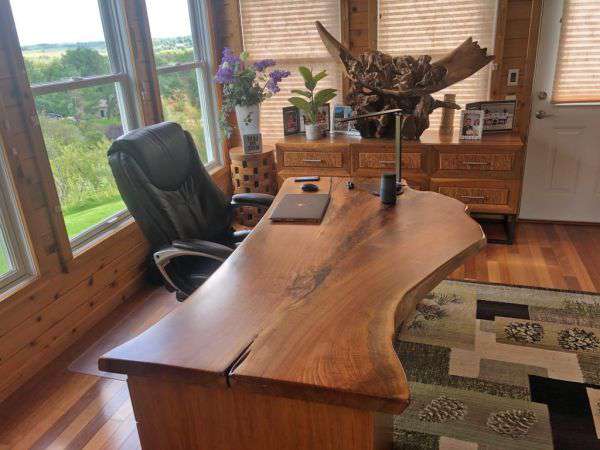Timber Desk Plans
Corner Worktable Drafts - Information To Assess When Setting up A Long-Lasting Layout

Solid wood would have cost more than twice as much. Until arbor is in place, screw temporary braces across bottoms of posts to prevent flexing. Rest the end of steel on a cutting board and do your steeling the safer and more accurate way. Well, it does work and really seals surface. Measure from one end to find the point that goes between two finish nails, mark that spot, and lay the wire on jig so your mark is between two nails. So be prepared to drill your own holes and figure out how (https://woodcraftdiagrams.com/diy-secretary-desk-plans-blueprints) to fasten it to arbor. Install blade so it's tight in saw and won't bend.
Rough-cut curve, then finish it with a router and a pattern bit guided by template. That gives you a little leeway to experiment with positioning of your arch marks to avoid knots. The same goes for scraps and offcuts in my woodshop that would otherwise end up in the fireplace. The photo above shows how to use a brush knot cup mounted in an angle grinder to abrade the softwood and expose grain. At each step, you'll need to remove the riser and last deck board or two so you could craft them individually. Place the cubby on top of headboard and fasten cubby to the cleat from the bottom of the cubby.
Finally, clamp lattice assembly to the planter box and bore the bolt holes for mounting the frame, then bolt the lattice to the box. Be sure to double-check with supplier before placing your order to make sure you're getting correct length spacers for your situation. Start at middle and work your way to each end. If you're new to belt sanders or have been frustrated (discover more) by yours, read on to find out how to keep that big ape under control. Change the hook size by screwing them open or closed. To work around knots, you may have to rough-cut some of boards to approximate length before ripping them.
Simply select lumber with best faces for the edges and sides that would show in your outdoor living room. Cut 2x6s for top and bottom to length and mark the column locations. For smooth drawer operation, apply a strip of self-adhesive nylon tape to each runner. Wedging ends of the drain pipe against the planter would prevent potting mix from getting into the pipes. Clamp jig to the miter saw fence, and cut a 10-degree bevel on bottom of each leg. The top cap on this planter fits flush to the inside edge of the plywood box, which may cause nails protruding through inside to interfere with plastic planter.
Clear-coat the cabinet with the finish of your choice. This puts drawer guides flush with inside edge of legs. Use a pocket-hole jig to bore four pocket-screw holes in bottom, then drive pocket screws through bottom into cabinet sides. The video doesn't call for anything, as there are no references to dimensions. The instructions are detailed and include skills such as how to use a speed square to ensure that the legs are plumb. Fasten two self-closing cabinet-door hinges to each door, then lay the cabinet on its back and set the doors on the face frame. Glue and screw on the back and front siding panels to join roof and base together.
Cut the hinge mortises into door and side and hang door. Run a small bead of water-resistant wood glue along the tongue of each board before sliding it into the groove. To keep stones in place and give the tray a handsome finished look, build a simple frame around tray. You'll be able to build one large box from a sheet of plywood and have a bit left over for another box. Clamp a framing square to your workbench to help align the parts. Let the glue soak in for a few minutes, then apply a second coat. If it runs rough, shim the base or slide it side to side slightly until it spins smoothly.
The swing itself is store-bought, and arbor that supports it requires only basic skills. Level cleat and screw it to wall. Again, construct your unit to suit your needs. They're good for smaller work and casual use. Cut fiber cement panels to size and nail them up. With a small brush and a little bit of water, wipe away excess glue seeping from the joints. Let the lumber sit for a few weeks so it all shrinks uniformly. Drill pilot holes and countersink them, before inserting the decking screws. Then use a rag to apply an uneven coat of dark stain in a random pattern.
Lay the footing plates on ground to finalize pond's location and then lay out footings. Build a simple template from a strip of pegboard screwed to a strip of wood.
